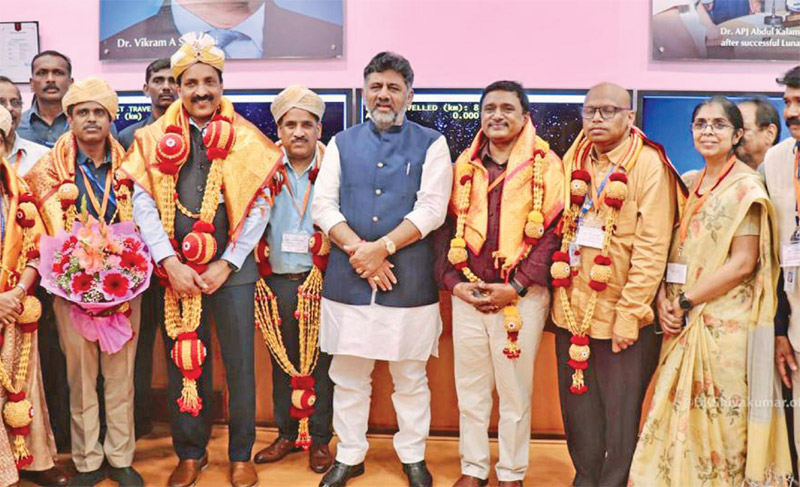State-owned defence enterprises need to study successes in high-technology space programmes
Atul Chandra
The Indian Space Research Organisation (ISRO) is now going through a purple patch of successes and the latest was the highly significant milestone of the Chandrayaan-3 spacecraft, which made India the first nation to land a lunar spacecraft on the south pole of the moon. Chandrayaan-3’s landing site has since been given the name Shiv Shakti by Prime Minister Narendra Modi.

The ISRO successfully launched the Chandrayaan-3 spacecraft into orbit on July 14 and the Vikram lander’s successful touchdown on the moon’s surface on August 23 made India the fourth country in the world to achieve such a significant technological capability. Following the landing the ISRO successfully deployed the Pragyan rover on the lunar surface. The lander and rover have a mission life of one lunar day, which is equal to 14 earth days.
Chandrayaan-3 is India’s third lunar exploration mission and was launched into space on the fourth operational mission of ISRO’s LVM3 launcher. The approved cost of the Chandrayaan-3 programme was Rs 250 crore, excluding the cost of the LVM3 launcher. The ISRO’s operational heavy lift LVM3 launch vehicle and has now completed six consecutive successful missions. The ISRO is now preparing for the Aditya L1 mission, which will be the first space based Indian effort to study the sun. The Aditya L1 spacecraft will be placed in a halo orbit around the Lagrange point 1 (L1) of the sun-earth system, which is about 1.5 million km from the earth.
Globally Competitive
The ISRO today is one of the world’s sixth largest space agencies. India is one of a handful of countries globally to have built extensive infrastructure needed to manufacture launchers, satellites, other space hardware and an extensive network of ground monitoring stations. India also has one of the largest fleets of communication satellites (INSAT) and remote sensing (IRS) satellites.
Unlike India’s state-supported defence industry, which has enjoyed decades of patronage, the ISRO, which is also a state-owned entity, has emerged as a globally competitive entity. While India’s state-owned defence enterprises are yet to compete at the global level, the ISRO has aspirations for Indian industry to play a major role in manufacturing ground equipment, satellites and satellite launch vehicles, in addition to supporting the global satellite data industry.
Despite its string of successes and growth into a globally competitive space agency, what is most interesting is that the ISRO is now looking to return to its roots as a research & development (R&D) agency. It is working to offload a greater share of the manufacturing, launch and operations for space missions to the Indian industry and their international partners.
The ISRO is moving towards becoming an R&D organisation, which was in fact the original intent of its creation, its chairman V Somnath said during a recent event in Bengaluru. Since India’s space infrastructure did not exist at the time of the ISRO’s creation, it had to also take up development of rockets, satellites and create the entire infrastructure for the same. “Today we are taking a lot of support from the Indian industry and much of the manufacturing which we used to do in-house has been moved out. When it comes to our satellites, 50 per cent is contributed by the Indian industry,” Somnath said.
The growing role of the Indian industry in the space sector has enabled the ISRO to accelerate the numbers of launches and placing of satellites into orbit. In the eighties and nineties, the ISRO used to manufacture only a few launchers and satellites annually, which limited its ability to undertake space missions. Today, the ISRO is building eight to nine satellites and launching the same number of rockets every year despite not having increased its manpower. Somnath attributes this increase in capacity to greater participation of the Indian industry. In fact, the ISRO has mastered the art of moving out high-technology work packages to the Indian industry.
The ISRO has launched over 100 satellites so far and has built a strong in-house satellite building capabilities for GSAT, earth observation satellites and space-based satellite navigation systems. The ISRO’s INSAT communication satellites and the IRS remote sensing satellites are catering to the increasing demand for fast and reliable communication and earth observation respectively. The ISRO has launched 389 foreign satellites since 2014, earning a revenue of USD 174 million. In April, the ISRO launched 104 satellites aboard PSLV-C37 from the Satish Dhawan Space Centre at Sriharikota, a new record. About 101 of the 104 satellites belonged to international customers.
New Approach
In a major step towards greater commercially exploitation of the R&D work done by ISRO centres and constituent units of the Department of Space (DOS); in March 2019, the union government set up New Space India Limited (NSIL), a wholly-owned government of India undertaking/Central Public Sector Enterprise (CPSE), under the administrative control of the DOS.
The NSIL was set up to meet the ever-increasing demands of the Indian space programme and to commercially exploit the emerging global space market. The NSIL has been incorporated to carry out the following roles and functions as part of its mandate viz. (i) small satellite technology transfer to industry wherein the NSIL will obtain licence from the DOS/ISRO and sub-licence it to Industries; (ii) manufacture of Small Satellite Launch Vehicle (SSLV) in collaboration with the private sector; (iii) Production of the Polar Satellite Launch Vehicle (PSLV) through Indian Industry; (iv) Production and marketing of space-based products and services, including launch and application; (v) Transfer of technology developed by ISRO centres and constituent units of the DOS; (vi) Marketing spin-off technologies and products/services, both in India and abroad; and (vii) any other subject which Government of India deems fit.
You must be logged in to view this content.

